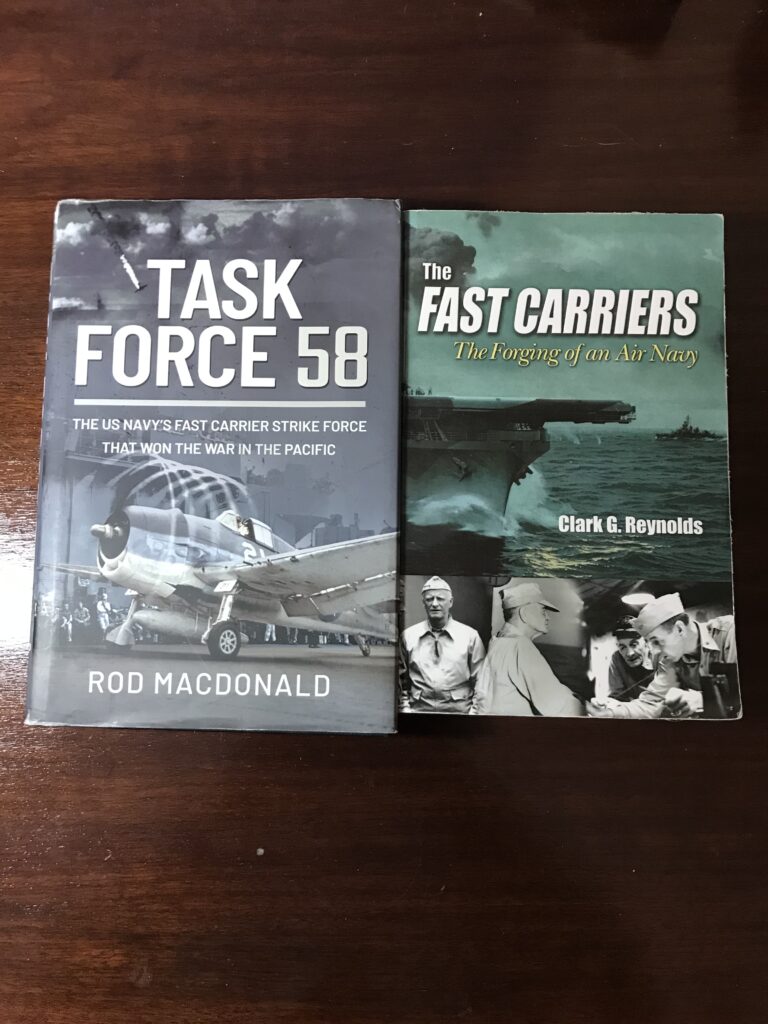Who Says Admirals Don’t Have A Sense of Humor?
I’ve been immersing myself in “all things Task Force 58,” which means reading books such as “The Fast Carriers: The Forging of An Air Navy,” and “Task Force 58: The US Navy’s Fast Carrier Strike Force That Won The war in the Pacific.” Both are extremely informative and have been very useful in teaching me about the strategies and tactics of the US Navy during World War II in the Pacific Theater.

But there’s not much, if any humor in either of them. So, while I didn’t laugh out loud when reading “Carrier War,” I did stop and savor the story related below. This book, unlike the first two, was published in 1945, likely while the war still raged. Written by Lieutenant Oliver Jensen, USNR, the book has a different “voice” than those written by historians. Written for civilian consumption, the book gives a “behind the scenes” look at the actions of Task Force 58. With a Forward written by the then “Assistant Secretary of the Navy For Air,” Artemus Gates, it was probably also published with the intent of helping the Navy establish a role in the post-war era.
The author, Lt. Jensen, served in both the Atlantic and Pacific, first in destroyers, then transferring to “naval aviation.” He authored numerous magazine articles during the war and then wrote this book.
A little backstory, beginning in the 1930’s there was a rivalry between the “Gun-Club” (those who believed battleships were the main battle weapon) and Naval Aviators. Each had different views on how to fight the coming war with Japan. Even though Japan’s attack on Pearl Harbor forced the Navy to rely on carriers rather than battleships, there was still, at times, strong disagreement between the two groups. By 1944, Admiral King, decided that Task Forces would represent the interests of both by having a naval aviator serve as a chief of staff to a non-aviator in command of the fleet or vice versa, a non-aviator would serve as chief of staff to a naval aviator.
Task Force 58 had Admiral Marc Mitscher, an aviator, in command. In early 1944, Captain Arleigh “Thirty-one Knot” Burke was made Mitscher’s chief of staff. Burke had previously served as the commander of the Navy’s destroyer squadrons in the Solomons (where Mitscher served as commander of air assets for the Navy).
Mitscher and his aviators were given the mission of supporting the invasion of Hollandia (now Jayapura) on the island of New Guinea. As it becomes evident that the invasion is successful and that the naval aviators have provided needed air support for the Army, congratulatory messages start to be traded among the ships.
As Jensen relates it,
“Admiral Mitscher is obviously in an expansive mood; two wisecracking blinker messages from his flagship prove it. Target of his jibes is famous “31-Knot” Burke, his new chief of staff.
“THIRTY-ONE KNOT BURKE IS NOW IN A PLANE OVER THE TARGET,” comes the flagship message, and is followed an hour or more later by another:
“THIRTY-ONE KNOT BURKE HAS RETURNED AND HAS AUTHORIZED THIS STATE MENT QUOTE: THE AIRPLANE IS HERE TO STAY1.”
(Alright, it’s not a knee slapper, but if you’ve read as many books as I have on a particular topic, ANY humor is appreciated.)
Jensen doesn’t say what Burke’s reaction was, hard charger that he was, he probably just ignored it. But later Mitscher and Burke would grow quite close and became personal friends before the war was over.
After the war, Jensen would go on to be a co-founder of American Heritage Magazine in 1954, edit it after Bruce Catton, and write several more books. He passed away in 2005.
1Oliver Jensen, Carrier War ( New York, Simon and Schuster, 1945) p 19.